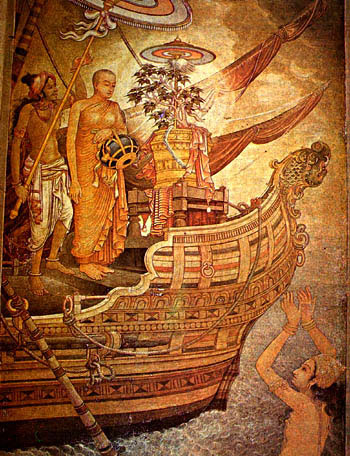Buddhist Art in ancient Sri Lanka
Paintings

A student of classical Sinhala paintings will find ample material in places such as Sigiriya, Hindagala, Polonnaruwa, Dambulla, etc., but he should not forget that the best samples of traditional Buddhist paintings are found in the relic chambers of ancient Stupas.
Though such examples are not plentiful, the few available in places like Mihintale and Mahiyangana are very important and useful.
When the unknown Stupa at Mihintale was excavated in 1951 archaeologists discovered paintings executed in two of the walls of a Relic Chamber in this Stupa. Paranavitana who carried out the excavation found these paintings artistically interesting and wrote as follows : The paintings depict divine beings among clouds which have cut off the lower parts of their bodies. The figures have been sketched in outline only, red and black being the pigments used, but are of high artistic quality indicating that the artist possessed skill in draughtsmanship, a subtle sense of form and an understanding of the principales of balanced composition.
Against a possible contention that what we see in the chamber are all that the artists intended to complete, and that the paintings are impressionistic sketches is the presence of vertical line dividing each scene into two-line which must have been drawn by the artist as an aid to balance grouping of the figures.
It can be said with certainty that the culture and art of Sri Lanka differ from those of mainland India solely because of Buddhism which generated free thought and expression in the lifestyle and the social organisation of the Sinhalese.
The indigenous thought and experience helped to develop what is known as Sinhala-Buddhist Art. The art forms that were very simple in the beginning began to grow in complexity as time went on.
“When we say that the culture and art (of Sri Lanka) form one aspect of the great culture and art of India, we do not mean that the works of art one would see in Sri Lanka are a mere repetition of what one would have seen in some parts or other of the Indian subcontinent.
The basic conceptions on which the ancient artists worked in Sri Lanka are the same as those which held good for their compeers in India, the methods and techniques are very often the same.
Motifs are found which are identical here as well as there; but at the same time certain characteristic features of early Indian art, which have undergone no development there, have been given much importance in Sinhalese art, and undergone evolution through a long period of time.
Similarly, some of the later developments in Indian Art – developments which have stamped the art of certain regions of the peninsula with an individuality – did not influence the course of artistic evolution among the Sinhalese”.
The above statement by the late Senarat Paranavitana finds ample support in the ruins of Mihintale – the birthplace of the culture of the Sinhala people.
– Source : www.lakehouse.lk




